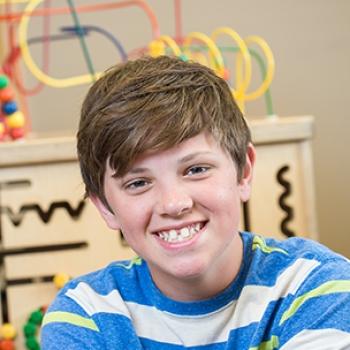Josef Sutcliffe

Josef Sutcliffe’s migraines were all in his head. ENT surgery fixed that.
Josef started getting headaches in first grade. By third grade he had frequent migraines – throwing up, avoiding light, missing school, sometimes rushing to the Emergency Department.
“He was only nine,” says Michele, his mom. “What 9-year-old gets migraines?”
Josef also had trouble with sleep, appetite, restless legs, even focusing his eyes. “I remember trying to focus on something at school and it would look like it was sliding around. Then I’d blink and everything was back in place,” he says.
They tried eyeglasses, a change in diet, and more. “We kind of exhausted all our thoughts on it,” Michele recalls.
Migraines can be hereditary, but there was no family history of it. “It was interesting that no one in our family had them and Josef just happened to have them,” Michele says. “It was clear there was something physical going on.”
At the same time, Michele suspected a separate problem with Josef’s enlarged tonsils; she brought him to ENT specialist Gerard O’Halloran, MD.
Dr. O’Halloran told Josef that migraines in the midface or forehead can signal a problem with turbinates, hotdog-shaped “radiators” deep inside the nose that warm, humidify and filter air as it’s breathed in. Symptoms include pressure beneath the eyes or pain around the eyes (and forehead); common triggers are weather changes, a head cold, exposure to smoke or perfume, even simply lying down.
A CT scan showed that Josef’s turbinates were enlarged, crowding the sensitive turbinates against the bony septum between the nostrils, and causing pain whenever the turbinates swell. The space between turbinates and septum is barely a millimeter, so even a little bit of swelling may cause headache or pain, Dr. O’Halloran explained.
“Nobody else had understood how the nose could be related to migraines, but Dr. O’Halloran did,” Michele says. “We were really relieved to feel like we were listened to, and someone understood how this was all related. To be able to understand how all the parts of the body work together – that was really great.”
Dr. O’Halloran performed surgery to reduce the width of Josef’s turbinates, and remove his tonsils.
Josef woke up with a bandaged nose and sore throat; he had a red popsicle, then went home within four hours after surgery and was fully recovered in two weeks.
His headaches are almost completely gone. “I can do things more freely now,” he says. “I don’t have to stop what I’m doing because of a headache.”
“He’s been a totally different kid,” Michele adds. “It was so hard because it felt like there was nothing we could do. Since the surgery, he’s had amazing success.”
Josef calls Dr. O’Halloran “the best doctor I’ve had. It’s like he always knew me. He kind of reminds me of my dad because he’s funny and joyful and I just kind of relate to him.”
Michele agrees: “He’s so personable. After surgery, he gave me his cell number – and right then I knew I’d never have to worry.”
Months later, Michele had her own CT scan, which showed the same turbinate structure as Josef’s. She doesn’t have migraines, but won’t hesitate to have surgery if headaches begin.
“I would for sure do it with Dr. O’Halloran,” she says. “There’s such a level of trust with him.”
